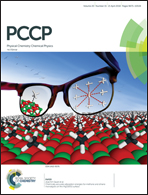One-pot production of porous assemblies by PISA of star architecture copolymers: a simulation study†
Abstract
The polymerization-induced self-assembly (PISA) process of star architecture copolymers is studied by dissipative particle dynamics and a reaction model. According to the simulation results, the porous vesicles can be produced directly by PISA of these copolymers. Average pore size and distribution of pore size can be influenced by αAS (the solubility between solvophilic blocks and solvent) and αAB (the solubility between solvophilic blocks and solvophobic blocks), while different self-assembly progress can be observed at different αAS and αAB. In addition, the star architecture can promote the formation of porous vesicles compared with linear copolymers. The steric effect of two solvophobic chains is verified as the key factor in formation of the porous vesicles. Further enhancement of such an effect can widen the range of αAS for production of porous vesicles, accompanied by a shrinkage of the range of αAB and a large reduction of pore size distribution. This work provides deeper understanding of the PISA of star architecture copolymers and is instructive in the experimental production of porous nano-materials.



 Please wait while we load your content...
Please wait while we load your content...